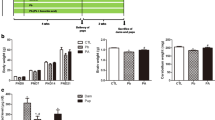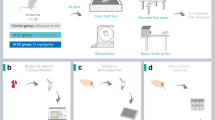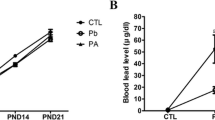Abstract
Accumulation of aluminium and acrylamide in food is a major source of human exposure. Their adverse effects are well documented, but there is no information about the health problems arising from their combined exposure. The aim of the present study was to examine the possible neurotoxic effects after co-exposure of pregnant and lactating rats to aluminium and acrylamide in order to evaluate redox state, cholinergic function and membrane-bound ATPases in the cerebellum of adult rats and their progeny. Pregnant female rats have received aluminium (50 mg/kg body weight) via drinking water and acrylamide (20 mg/kg body weight) by gavage, either individually or in combination from the 14th day of pregnancy until day 14 after delivery. Exposure to these toxicants provoked an increase in malondialdehyde (MDA) and advanced oxidation protein product (AOPP) levels and a decrease in SOD, CAT, GPx, Na+K+-ATPase, Mg2+-ATPase and AChE activities in the cerebellum of mothers and their suckling pups. A reduction in GSH, NPSH and vitamin C levels was also observed. These changes were confirmed by histological results. Interestingly, co-exposure to these toxicants exhibited synergism based on physical and biochemical variables in the cerebellum of mothers and their progeny.




Similar content being viewed by others
Abbreviations
- AChE:
-
Acetylcholinesterase
- ACR:
-
Acrylamide
- AlCl3 :
-
Aluminium chloride
- AOPP:
-
Advanced oxidation protein product
- CAT:
-
Catalase
- DNPH:
-
Dinitrophenyl hydrazine
- DTNB:
-
5,5′-Dithiobis-2-nitrobenzoic acid
- EGL:
-
External granular layer
- GPx:
-
Glutathione peroxidase
- GSH:
-
Reduced glutathione
- IGL:
-
Internal granular layer
- MDA:
-
Malondialdehyde
- ML:
-
Molecular layer
- NPSH:
-
Non-protein thiol
- PCL:
-
Purkinje cell layer
- SOD:
-
Superoxide dismutase
- TBA:
-
Thiobarbituric acid
- TBARS:
-
Thiobarbituric acid-reactive substances;
References
Exley C, Burgess E, Day JP, Jeffery EH, Melethil S, Yokel RA (1996) Aluminum toxicokinetics. J Toxicol Environ Health 48:569–584
Karbouj R, Desloges I, Nortier P (2009) A simple pre-treatment of aluminium cookware to minimize aluminium transfer to food. Food Chem Toxicol 47:571–577
Gonzalez MA, Bernal CA, Mahieu S, Carrillo MC (2009) The interaction between the chronic exposure to aluminium and liver regeneration on bile flow and organicanion transport in rats. Biol Trace Elem Res 127:164–176
Roskams AJ, Connor JR (1990) Aluminum access to the brain: a role for transferring and its receptors. Proc Natl Acad Sci 87:9024–9027
Mahieu S, Contini MC, Gonzalez M (2000) Aluminum toxicity: hematological effects. Toxicol Lett 111:235–242
Percy ME, Kruck TP, Pogue AI, Lukiw WJ (2011) Towards the prevention of potential aluminum toxic effects and effective treatment for Alzheimer’s diseases. J Inorg Biochem 105:1505–1512
Oyanagi K (2005) The nature of the parkinsonism-dementia complex and amyotrophic lateral sclerosis of Guam and magnesium deficiency. Parkinsonism Relat Disord 1:17–23
Bondy SC (2010) The neurotoxicity of environmental aluminum is still an issue. Neurotoxicology 31:575–581
Colomina MT, Roig JL, Torrente M, Vicens P, Domingo JL (2005) Concurrent exposure to aluminum and stress during pregnancy in rats: effects on postnatal development and behavior of the offspring. Neurotoxicol Teratol 27:565–574
Yousef MI, Kamel KI, El-Guendi MI, El-Demerdash FM (2007) An in vitro study on reproductive toxicity of aluminium chloride on rabbit sperm: the protective role of some antioxidants. Toxicology 239:213–223
Guo CH, Hsu GSW, Chuang CJ, Chen PC (2009) Aluminum accumulation induced testicular oxidative stress and altered selenium metabolism in mice. Environ Toxicol Pharmacol 27:176–181
CDC (2009) Fourth National Report on Human Exposure To Environmental Chemicals. Center for Disease Control and Prevention. U.S. Department of Health and Human Services, Atlanta, USA
Friedman M (2003) Chemistry, biochemistry and safety of acrylamide. A review. J Agric Food Chem 51:4504–4526
Tareke E, Ryberg P, Karsson P, Ericsson S, Tornqvist M (2002) Analysis of acrylamide, a carcinogen formed in heated foodstuffs. J Agric Food Chem 50:4998–5006
Sumner SC, Fennell TR, Moore TA, Chanas B, Gonzalez F, Ghanayem B (1999) Role of cytochrome P450 2E1 in the metabolism of acrylamide and acrylonitrile in mice. Chem Res Toxicol 12:1110–1116
Lopachin RM (2004) The changing view of acrylamide neurotoxicity. Neurotoxicology 25:617–630
Lopachin RM, Barber DS, He D, Das S (2006) Acrylamide inhibits dopamine uptake in rat striatal synaptic vesicles. Toxicol Sci 89:224–234
Allam AA, El-Ghareeb AW, Abdul-Hamid M, Bakery AE, Gad M, Sabri M (2010) Effect of prenatal and perinatal acrylamide on the biochemical and morphological changes in liver of developing albino rat. Arch Toxicol 84:129–141
Tiffany-Castiglioni E, Hong S, Qian Y, Tang Y, Donnelly KC (2006) In vitro models for assessing neurotoxicity of mixtures. NeuroToxicol 27:835–839
Council of European Communities, Council instructions about the protection of Living animals used in scientific investigations. Official Journal of the European Communities (JO 86/609/CEE) 358 (1986) 1–18.
Fishbeck KL, Rasmussen KM (1987) Effect of repeated cycles on maternal nutritional status, lactational performance and litter growth in ad libitum-fed and chronically food-restricted rats. J Nutr 117:1967–1975
Lowry OH, Rosebrugh NJ, Farr AL, Randall RJ (1951) Protein measuremernt with the Folin phenol reagent. J Biol Chem 193:265–275
Draper HH, Hadley M (1990) Malondialdehyde determination as index of lipid peroxidation. Methods Enzymol 186:421–431
Kayali R, Cakatay U, Akcay T, Altug T (2006) Effect of alpha-lipoic acid supplementation on markers of protein oxidation in post-mitotic tissues of ageing rat. Cell Biochem Funct 24:79–85
Ellman GL (1959) Tissue sulfhydryl groups. Arch Biochem Biophys 82:70–77
Jollow DJ, Mitchell JR, Zampaglione N, Gillette JR (1974) Bromobenzene-induced liver necrosis. Protective role of glutathione and evidence for 3,4-bromobenzene oxide as the hepatotoxic metabolite. Pharmacology 11:151–169
Jacques-Silva MC, Nogueira CW, Broch LC, Flores EMM, Rocha JBT (2001) Diphenyl diselenide and ascorbic acid changes deposition of selenium and ascorbic acid in liver and brain of mice. J Pharmacol Toxicol 88:119–125
Aebi H (1984) Catalase in vitro. Methods Enzymol 105:121–126
Flohe L, Gunzler WA (1984) Assays of glutathione peroxidase. Methods Enzymol 105:114–121
Beauchamp C, Fridovich I (1971) Superoxide dismutase: improved assays and an assay applicable to acrylamide gels. Anal Biochem 44:276–287
Ellman GL, Courtney KD, Andres V, Featherstone R (1961) A new and rapid colorimetric determination of acetyl cholinesterase activity. Biochem Pharmacol 7:88–95
Kawamoto EM, Munhoz CD, Glezer I, Bahia VS, Caramelli P, Nitrini R, Gorjao R, Curi R, Scavone C, Marcourakis T (2005) Oxidative state in platelets and erythrocytes in aging and Alzheimer’s disease. Neurobiol Aging 26:857–864
Lu H, Yuan G, Yin Z, Dai S, Jia R, Xu J, Song X, Li L, Lv C (2014) Effects of subchronic exposure to lead acetate and cadmium chloride on rat’s bone: Ca and Pi contents, bone density and histopathological evaluation. Int J Clin Exp Pathol 7:640–647
Allam A, El-Ghareeb AA, Abdul-Hamid M, Baikry A, Sabri MI (2011) Prenatal and perinatal acrylamide disrupts the development of cerebellum in rat: biochemical and morphological studies. Toxicol Ind Health 27:291–306
Yousef MI (2004) Aluminum induced changes in hemato-biochemical parameters, lipid peroxidation and enzyme activities of male rabbits: protective role of ascorbic acid. Toxicology 199:47–57
Kaur A, Gill KD (2006) Possible peripheral markers for chronic aluminium toxicity in Wistar rats. Toxicol Ind Health 22:39–46
Justin Thenmozhi A, Raja TR, Janakiraman U, Manivasagam T (2015) Neuroprotective effect of hesperidin on aluminium chloride induced Alzheimer’s disease in Wistar rats. Neurochem Res 40:767–776
Sharma P, Mishra KP (2006) Aluminum-induced maternal and developmental toxicity and oxidative stress in rat brain: response to combined administration of Tiron and glutathione. Reprod Toxicol 21:313–321
Sorgel F, Weissenbacher R, Kinzig-Schippers M, Hofmann A, Illauer M, Skott A (2002) Acrylamide: increased concentrations in homemade food and first evidence of its variable absorption from food, variable metabolism and placental and breast milk transfer in humans. Chemotherapy 48:267–274
Takahashi M, Shibutani M, Inoue K, Fujimoto H, Hirose M, Nishikawa A (2008) Pathological assessment of the nervous and male reproductive systems of rat offspring exposed maternally to acrylamide during the gestation and lactation periods—a preliminary study. J Toxicol Sci 33:11–24
Samson FE, Nelson SR (2000) The aging brain, metals and oxygen free radicals. Cell Mol Biol 46:699–707
Sies H, Stahl W, Sundkist AR (1992) Antioxidant functions of vitamins. Vitamins E and C, beta-caroten, and other carotenoides. Ann N Y Acad Sci 669:7–20
Catala A (2007) The ability of melatonin to counteract lipid peroxidation in biological membranes. Curr Mol Med 7:632–649
Yumoto S, Nagai H, Matsuzaki H, Matsumura H, Tada W, Nagatsuma E, Kobayashi K (2001) Aluminium incorporation into the brain of rat fetuses and sucklings. Brain Res Bull 55:229–234
Yumoto S, Nagai H, Kobayashi K, Tamate A, Kakimi S, Matsuzaki H (2003) 26Al incorporation into the brain of suckling rats through maternal milk. J Inorg Biochem 97:155–160
Barber DS, Stevens S, LoPachin RM (2007) Proteomic analysis of rat striatal synaptosomes during acrylamide intoxication at a low dose rate. Toxicol Sci 100:156–167
Chen JH, Yang CH, Wang YS, et al. (2013) Acrylamide-induced mitochondria collapse and apoptosis in human astrocytoma cells. Food Chem Toxicol 51:446–452
Kraus-Friedman N, Bibes J, Muren H, Carafoli E (1982) Calcium uptake in isolated hepatic plasma membrane vesicles. Eur J Biochem 129:7–12
Takahashi M, Shibutani M, Nakahigashi J, Sakaguchi N, Inoue K, Morikawa T (2009) Limited lactational transfer of acrylamide to rat offspring on maternal oral administration during the gestation and lactation periods. Arch Toxicol 83:785–793
Erecińska M, Silver IA (1994) Ions and energy in mammalian brain. Prog Neurobiol 43:37–71
Siraj Mohiyuddin S, Rajeswara Reddy S, Ananda Kumar L, Jacob Doss P (2010) Acephate induced alterations in Mg2+ and Na+K+ ATPases of different brain regions of albino rats. Biasean 5:153–156
Dua R, Gill KD (2004) Effect of aluminum phosphide exposure on kinetic properties of cytochrome oxidase and mitochondrial energy metabolism in rat brain. Biochim Biophys Acta 1674:4–11
Gill KD, Dua R, Kumar V (2010) Impairment of mitochondrial energy metabolism in different regions of rat brain following chronic exposure to aluminum. Food Chem Toxicol 48:53–60
Yang WN, Han H, Hu XD, Feng GF, Qian YH (2013) The effects of perindopril on cognitive impairment induced by d-galactose and aluminum trichloride via inhibition of acetylcholinesterase activity and oxidative stress. Pharmacol Biochem Behav 114-115:31–36
Reyes AE, Perez DR, Alvarez A, Garrido J, Gentry MK, Doctor BP, Inestrosa NC (1997) A monoclonal antibody against acetylcholinesterase inhibits the formation of amyloid fibrils induced by the enzyme. Biochem Biophys Res Commun 232:652–655
Nehru B, Bhalla P, Garg A (2006) Evidence for centrophenoxine as a protective drug in aluminium induced behavioral and biochemical alteration in rat brain. Mol Cell Biochem 290:33–42
Julka D, Sandhir R, Gill KD (1995) Altered cholinergic metabolism in rat CNS following aluminum exposure: implications on learning performance. J Neurochem 65:2157–2164
Domingo JL (2006) Aluminum and other metals in Alzheimer’s disease: a review of potential therapy with chelating agents. J Alzheimers Dis 10:331–341
Colomina MT, Roig JL, Sanchez DJ, Domingo JL (2002) Influence of age on aluminum-induced neurobehavioral effects and morphological changes in rat brain. Neurotoxicology 23:775–781
Miu AC, Andreescu CE, Vasiu R, Olteanu AI (2003) A behavioral and histological study of the effects of long-term exposure of adult rats to aluminum. Int J Neurosci 113:1197–1211
Hasebe M, Matsumoto I, Imagawa T, Uehara M (2008) Effects of an anti-thyroid drug, methimazole, administration to rat dams on the cerebellar cortex development in their pups. Int J Dev Neurosci 26:409–414
Farwell AP, Dubord-Tomasettia SA, Pietrzykowskia AZ, Stachelekb SJ, Leonarda JL (2005) Regulation of cerebellar neuronal migration and neurite outgrowth by thyroxine and 3,3,’,5′-triiodothyronine. Dev Brain Res 154:121–135
Robbins S, Angell D (1976) Basic pathology, 2nd edn. W.B. Saunders Company, Philadelphia, London
Sherlock S, Doely J (1993) Diseases of the liver and biliary system, 9th edn. Blackwell Scientific Publication, Cambridge, London
Acknowledgments
This work was supported by the Ministry of Higher Education and Scientific Research in Tunisia (DGRST grants, LR/11ES-53).The authors are indebted to Mr. Menaa Assili and Mr. Chedli Tmar for their skilful technical assistance.
Author information
Authors and Affiliations
Corresponding author
Ethics declarations
The general guidelines for the use and care of living animals in scientific investigations were followed (Council of European Communities: JO 86/609/CEE, 1986). The handling of the animals and the care and use of laboratory animals were approved by the Tunisian Ethical Committee of Sciences Faculty of Sfax.
Conflict of Interest Statement
The authors declare that they have no competing interests.
Additional information
Ibtissem Ben Amara and Naourez Ktari contributed equally to this work
Rights and permissions
About this article
Cite this article
Ghorbel, I., Amara, I.B., Ktari, N. et al. Aluminium and Acrylamide Disrupt Cerebellum Redox States, Cholinergic Function and Membrane-Bound ATPase in Adult Rats and Their Offspring. Biol Trace Elem Res 174, 335–346 (2016). https://doi.org/10.1007/s12011-016-0716-1
Received:
Accepted:
Published:
Issue Date:
DOI: https://doi.org/10.1007/s12011-016-0716-1




